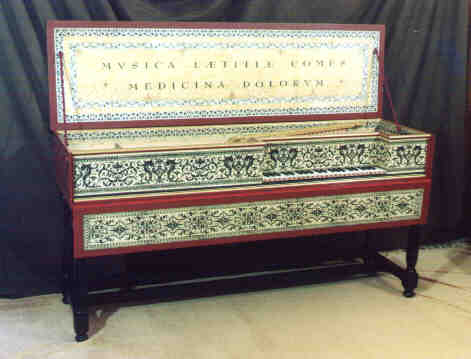
Muselaar según/after Ihoannes Ruckers 1611
Marianne Lilian Pérez Robledo
Luthier - Harpsichord maker
www.lpr-luthier.com.ar
Buenos Aires - Argentina - 2004

Decoración: Anabella
Pérez Cruces
Fotos: César Peret ( cesarperet@hotmail.com )
Muselaar (muselaar virginal)
El misterio de su sonido / The mistery of its sound
En el clave y la espineta, las cuerdas se apoyan en un puente (que capta el sonido de la cuerda) ubicado sobre la tabla armónica y en una cejuela, ubicada sobre el clavijero (que solo sirve de apoyo mudo para el otro extremo de la cuerda).
En el muselaar, a diferencia del clave y la espineta, las cuerdas se apoyan sobre dos puentes, ubicados sobre la tabla armónica. Ambos captan el sonido de la cuerda, pero tienen distinta forma y ubicación, produciendo así un especial sonido estereofónico de distinto timbre, proveniente del lado izquierdo y derecho al frente del intérprete.
Según la ubicación del teclado, se puede diferenciar entre el spinet virginal (con el teclado desplazado hacia la izquierda), y el muselaar virginal (con el teclado desplazado hacia la derecha).
En el clave, la espineta y el spinet virginal , la cuerda es tañida por un plectro, relativamente cerca de la cejuela, pero en el muselaar virginal , el plectro tañe la cuerda cerca de su nodo central, produciendo un sonido aflautado, sumamente apreciado en la época, ideal para la interpretación de música polifónica. El muselaar aparece reiteradamente en los cuadros de Johannes Vermeer van Delft (1632-1675) y otros maestros flamencos.
Muchos virginales flamencos, como en este caso, están dotados de un registro de arpicordium, que afecta a poco más de la mitad grave del teclado. Este registro, cuando está aplicado, produce un sonido similar al de la guimbarda, y era usado en piezas con una línea de basso ostinato y otra superior que cantaba una melodía (ej. muchas piezas que se encuentran en el Fitzwilliam Virginal Book, c. 1609-1919). /
In the harpsichord and the spinet, the strings are supported by a bridge (that capture the sound and transmits it to the soundboard) and a nut, located over the wrestplank (which only serves to mute support for the other end of the string).
In the muselaar, unlike the harpsichord and the spinet, the strings are supported by two bridges, both located on the soundboard. Both of them captures the sound of the string, but as they have diferent shape and location, they produces a special stereophonic sound of noticeable diferent tone quality, coming from both sides in the front of the player.
Depending on the location of the keyboard, it can be distinguish between the spinet virginal (whit the keyboard positioned to the left), and thel muselaar virginal (with the keyboard to the right).
In the harpsichord, the spinet and the spinet virginal, the string is plucked by a plectra, relatively close to the nut, but in the muselaar virginal , that plectra plucks the string near its central node, producing a fluty sound, highly appreciated at the time, ideal for the interpretation of poliphonic music. The muselaar appears in many pictures of flemish artists like Johannes Vermeer van Delft (1632-1675).
Many flemish virginals, like in the case of this muselaar, have an arpicordium stop, that works on a little more than the bass half of the compass. This stop, when engaged, produces a sound very similar to the jaw harp, and were used in pieces with a basso ostinato line and another one in the treble that sang the melody (e.g. many pieces found in the Fitzwilliam Virginal Book, c. 1609-1919).